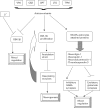Pharmacotherapy of Acute Bipolar Depression in Adults: An Evidence Based Approach
- PMID: 27274384
- PMCID: PMC4891315
- DOI: 10.4082/kjfm.2016.37.3.137
Pharmacotherapy of Acute Bipolar Depression in Adults: An Evidence Based Approach
Abstract
In the majority of cases of bipolar disorder, manic episodes are usually brief and typically responsive to currently available psychopharmacological agents. In contrast, depressive manifestations are more prevalent and persistent, and can present as major depressive/mixed episodes or residual interepisode symptoms. The depressive phase is often associated with other neuropsychiatric conditions, such as anxiety spectrum disorders, substance use disorders, stressor-related disorders, and eating disorders. It is viewed as a systemic disease with associated ailments such as metabolic syndrome, diabetes mellitus, and cardiovascular disease. There is an increased rate of mortality not only from suicide, but also from concomitant physical illness. This scenario is made worse by the fact that depressive symptoms, which represent the main disease burden, are often refractory to existing psychotropic drugs. As such, there is a pressing need for novel agents that are efficacious in acute depressive exacerbations, and also have applicable value in preventing recurrent episodes. The rationale of the present review is to delineate the pharmacotherapy of the depressive phase of bipolar disorder with medications for which there is evidence in the form of observational, open-label, or double-blind randomized controlled studies. In the treatment of acute bipolar depression in adults, a comprehensive appraisal of the extant literature reveals that among mood stabilizers, the most robust proof of efficacy exists for divalproex sodium; while atypical antipsychotics, which include olanzapine, quetiapine, lurasidone, and cariprazine, are also effective, as demonstrated in controlled trials.
Keywords: Anticonvulsants; Atypical Antipsychotics; Bipolar Depression; Drug Therapy; Mood Stabilizers.
Conflict of interest statement
Figures




Similar articles
-
Rationale for using lithium in combination with other mood stabilizers in the management of bipolar disorder.J Clin Psychiatry. 2003;64 Suppl 5:18-24. J Clin Psychiatry. 2003. PMID: 12720480 Review.
-
Pharmacotherapy of bipolar disorder with quetiapine: a recent literature review and an update.Clin Psychopharmacol Neurosci. 2015 Apr 30;13(1):25-35. doi: 10.9758/cpn.2015.13.1.25. Clin Psychopharmacol Neurosci. 2015. PMID: 25912535 Free PMC article.
-
[Guidelines for the prescription of mood stabilizers for adolescents: A literature review].Encephale. 2017 Oct;43(5):464-470. doi: 10.1016/j.encep.2016.09.005. Epub 2016 Nov 18. Encephale. 2017. PMID: 27871720 Review. French.
-
Maintenance therapies in bipolar disorder: focus on randomized controlled trials.Aust N Z J Psychiatry. 2005 Aug;39(8):652-61. doi: 10.1080/j.1440-1614.2005.01649.x. Aust N Z J Psychiatry. 2005. PMID: 16050919 Review.
-
Treating mixed mania/hypomania: a review and synthesis of the evidence.CNS Spectr. 2017 Apr;22(2):177-185. doi: 10.1017/S1092852916000845. Epub 2016 Dec 22. CNS Spectr. 2017. PMID: 28004626 Review.
Cited by
-
Mixed States in Bipolar Disorder: Etiology, Pathogenesis and Treatment.Chonnam Med J. 2017 Jan;53(1):1-13. doi: 10.4068/cmj.2017.53.1.1. Epub 2017 Jan 25. Chonnam Med J. 2017. PMID: 28184334 Free PMC article. Review.
-
Use of antipsychotics and the risk of acute respiratory failure among adults: A disease risk score-matched nested case-control study.Br J Clin Pharmacol. 2020 Nov;86(11):2204-2216. doi: 10.1111/bcp.14321. Epub 2020 May 30. Br J Clin Pharmacol. 2020. PMID: 32337738 Free PMC article.
References
-
- Ketter TA. Diagnostic features, prevalence, and impact of bipolar disorder. J Clin Psychiatry. 2010;71:e14. - PubMed
-
- Krishnan KR. Psychiatric and medical comorbidities of bipolar disorder. Psychosom Med. 2005;67:1–8. - PubMed
-
- Sienaert P, Lambrichts L, Dols A, De Fruyt J. Evidence-based treatment strategies for treatment-resistant bipolar depression: a systematic review. Bipolar Disord. 2013;15:61–69. - PubMed
Publication types
LinkOut - more resources
Full Text Sources
Other Literature Sources
Research Materials

